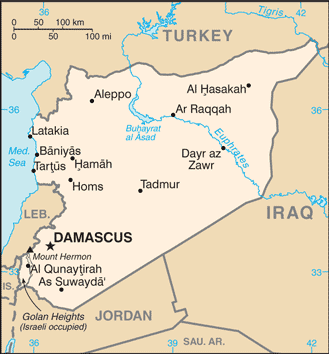Topics Covered
Welcome to Syria
Overview of Resources
Metals
Industrial Minerals
Fossil Fuels
Investment
Sources
Welcome to Syria
Syria is part of the Middle East countries located between Turkey and Lebanon. The total area of the country is 185,180 km2, and it has a population of 22,530,746 as of July 2012. The country’s climate is mostly desert type.
 |
The national flag of Syria.
Image Credit: CIA Factbook. |
Syria became an independent nation in 1946 and ever since was troubled by political instability and friction with Israel and Lebanon. The anti-government protests in the neighboring countries ignited the Syrians to engage in the same in 2011. The Syrian government used force to stop the demonstrations, but later tried to appease the people with some reforms. However, a civil war situation currently plagues the nation with nearly 10,000 people already dead.
The global economic downturn, civil war, international sanctions, and low domestic consumption and production have slowed down Syria’s GDP growth. The GDP of the country in 2011 was recorded as $107.6 billion.
The natural resources of Syria include iron ore, crude oil, phosphate rock, manganese ore, asphalt, marble, rock salt, and gypsum. The government controls most of the economic activities.
Overview of Resources
Syria accounted for about 2% of the world’s supply of phosphate rock in 2010. It ranked ninth in the world in phosphate rock production.
The mining sector also produced cement, marble, natural crude asphalt, nitrogen fertilizer, phosphate fertilizer, salt, steel, gypsum, and industrial sand.

The map of Syria. Image Credit: CIA Factbook
Metals
Syria’s net imports of steel products amounted to 2.2 Mt and consisted of crude, semi-finished, and finished steel in 2010. Most of the imports were from Ukraine and Russia.
In that year, Hmisho Steel produced low and medium grade carbon-content rebar from its newly constructed mill in Latakia. The company was also involved in construction of a new billet plant at Adra Industrial City.
Industrial Minerals
Syria’s cement production was about 10 million Mt/yr at the end of 2010.
In 2010, General Organization for Cement and Building Materials (GOCBM) operated eight state-owned cement plants in Syria, and produced more than 5 Mt of cement. Likewise, a cement plant operated by Military Housing Establishment of the Ministry of Defense produced 293,000 Mt of cement.
GOCBM was also involved in upgrading and expanding operations in 2010 at its Tartus plant. Saudi Arabia’s Pharon Commercial Investment Group provided $50 million for the expansion in exchange for 400,000 t/yr of the plant’s production.
In 2010, a $164 million flat-glass plant operated by First Glass, a subsidiary of Kaveh Glass Industry Group of Iran, was designed with the capacity to produce 10,000 t/yr of glass.
Syria’s phosphate rock production amounted to about 3.8 Mt in 2010. This was a 70% increase compared to 2009 production of 2.1 Mt. The increase was attributed to the increase in global demand for phosphate rock. In the same year, Syria struck a deal with India to start a joint-venture company aimed at developing phosphate rock production facilities.
Fossil Fuels
Syria’s total natural gas production in 2010 saw an increase of 37% to 7.8 billion m3 from 5.7 billion m3 in 2009. The increased output from Ebla Petroleum Co., Oudeh Petroleum Co., Abu Kamal Petroleum, and Syria-Sino Alkawkab Oil Co. was the reason behind the overall increase. The entire production was used for domestic consumption and some more was imported from Egypt.
In 2010, the government opened the Ebla gas plant at Al-Freqlus. The 2.5 million m3/d capacity plant was jointly operated by Suncor Energy Inc. of Canada and Petrofac Co. Ltd. of UK.
By the end of 2010, it was estimated that Syria’s proved petroleum reserves amounted to about 2.5 billion bbl.
Foreign companies operating in Syria are as follows:
- Dijla Petroleum Co.
- Al-Furat Petroleum Co.
- Oudeh Oil Co.
- Dier Ezour Petroleum Co.
- Hayan Petroleum Co.
- Sino Syrian Al Kawkab Oil Co.
Together these companies produced 180,000 bb/d while the state-owned Syrian Petroleum Co. (SPC) produced more than 191,000 bbl/d of crude oil and condensates in 2010.
Investment
According to reports, the mining sector of Syria is expected to continue producing phosphate rock and phosphate fertilizer production. However, this production may be hit due to the growing tensions between Syria and its neighbor, Turkey.
The country’s economy will totally depend on the outcome of the civil war in the next couple of years. Experts say that if proper reforms are implemented and transparency at all levels of the government is achieved, there is hope for progress as international companies are keen to invest in its mining sector.
Disclaimer: The Author of this article does not imply any investment recommendation and some content is speculative in nature. The Author is not affiliated in any way with any companies mentioned and all statistical information is publically available.
Sources
Disclaimer: The views expressed here are those of the author expressed in their private capacity and do not necessarily represent the views of AZoM.com Limited T/A AZoNetwork the owner and operator of this website. This disclaimer forms part of the Terms and conditions of use of this website.